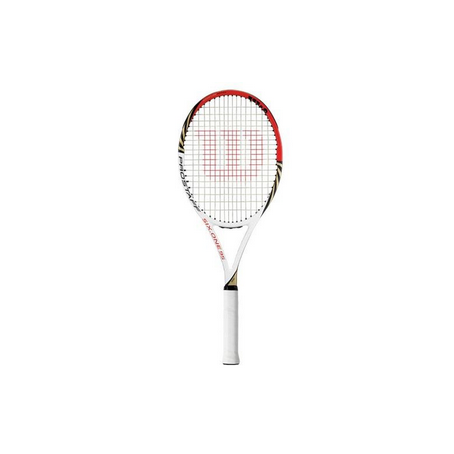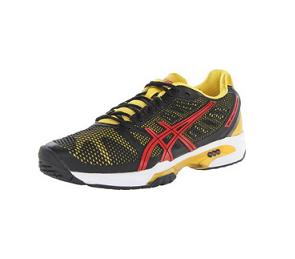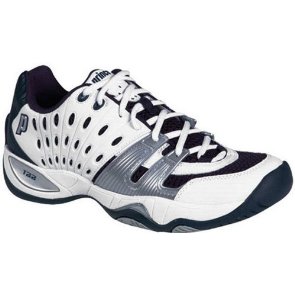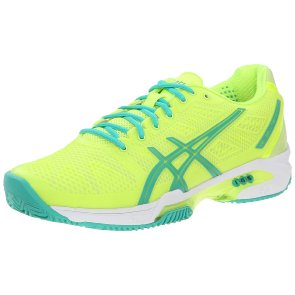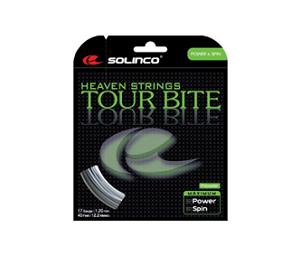
There are five basic types of tennis strings available on the market and selecting the correct one for your game is not just a matter of selecting the best but those that are the best tennis strings to suit your style of play.
Before making a final decision on the brand and type of tennis strings you want, there are a few important considerations to consider. Price is obviously a consideration but you also have to decide on whether you are a power player or prefer placing the ball accurately. Do you want strings that are easier on your arm muscles or do you rely on strength and speed?
Below is a brief guide to the kinds of strings available and some of their good and bad points.
Top 6 Tennis Strings Complete Table
| Picture | Name | String Category | Price | Rating (1-5) |
|---|---|---|---|---|
 | 1. Solinco Tour Bite Tennis String Set - 17 gauge - 1.20mm | Polyester Monofilament | $$ | 4.8 |
 | 2. Head Rip Control Tennis String | Polyamide Multifilament | $$ | 4.6 |
 | 3. RPM Blast Black 17g Strings | Polyester Monofilament | $$$ | 4.5 |
 | 4. Luxilon Big Banger Alu Power Rough 125 Silver String | Polyester Monofilament | $$$ | 4.4 |
 | 5. Wilson NXT Tour 17 Tennis Racquet String | Polyester Multifilament | $$$$ | 4.4 |
 | 6. Prince Synthetic Gut with Duraflex 16g White Tennis String | Synthetic Gut | $ | 4.3 |
The Five Categories of Tennis Strings
- Natural Gut. Generally accepted to be the best, natural gut strings are also the most expensive. As the name implies, these strings are made from natural gut (usually cow’s intestines) and holds their tension longer giving a consistent performance over time. Despite recent improvements, natural gut is still relatively fragile and susceptible to breaking as well as being less effective in wet conditions.
- Synthetic Gut. A lot cheaper than the real thing, synthetic gut strings are usually nylon based but polyester is also used and, to a lesser extent, Kevlar. Not as good as natural gut, synthetic strings have improved in recent years and are a less expensive option.
- Multifilament. Usually made from nylon strands and braided together using urethane, these strings are normally used when extra power in serving and volleying is required. The problem with multifilament strings is that they lose their tension quicker than natural gut.
- Monofilament. These strings are usually, but not always, polyester based and are easier on the arm muscles. Generally used by beginners, the big drawback to monofilament strings is that they lose their tension rather rapidly.
- Hybrid. As the name suggests, hybrid strings are a mixture of different kinds of strings taking the best features of others to achieve the best possible mix for the individual player’s style. These are very popular with professional players who want the best of all worlds.
Top 3 Best Tennis Strings Reviews
1. Solinco Tour Bite

Probably no professional tennis player would argue with the superiority of natural gut strings but, then again, I am not a professional player. Although not made of natural gut but a polyester monofilament, the Solinco Tour Bites are undoubtedly my favourite tennis strings. In terms of performance and power they do everything you would expect from a top quality product. I am far from being a pro player (and, at my age, I guess I never will be) but these strings suit me perfectly.
When I am (rarely) on my game, the Tour Bite strings increase the power in my serve and shots and my spin returns also seem noticeably improved but that wouldn’t be too difficult.
For a reasonable outlay (compared to natural gut strings), I have no hesitation in recommending the Solinco Tour Bite strings to anyone who enjoys their tennis as a sport and not as a career.
2. Head Rip Control

The Rip Control strings from HEAD are a multifilament polyamide (English translation – a mix of nylon and Kevlar) which, according to the manufacturers give increased ball control with added topspin and are built to last. I can certainly vouch for the “added topspin” as I am prone to overdo it when using my Rip Control strings.
HEAD also claim that the polyamide strings are the closest you can get to natural gut and it is hard to disagree. Although more strength is required for serving, other differences are negligible and, if anything, I actually prefer these strings to natural gut although that could be considered as blasphemy in certain circles.
While I cannot vouch for the durability as I have only had my Rip Control strings a matter of weeks, I can say that they have lasted this long without any noticeable loss of tension and my topspin continues to be as formidable as ever. Well, at least in my opinion!
3. RPM Blast Black

The Babolat RPM Blasts are another excellent value monofilament set of strings. The big plus of these strings is the strength you save in serving as the stiff polyester strings add power to your serve with less effort than is required with natural gut strings. Another bonus is the increased top spin they apply to the ball without the additional stretching normally involved.
The strings are silicone coated which allows more elasticity but also increases their durability and prolongs their life before replacements are necessary.
While I am still a big fan of natural gut strings, I find myself being persuaded more and more by the other options now available. Natural gut may still be the King of the Strings but synthetic gut, mono-and multifilament are rapidly closing the gap and the Babolat RPM strings are one of the best tennis strings available.

